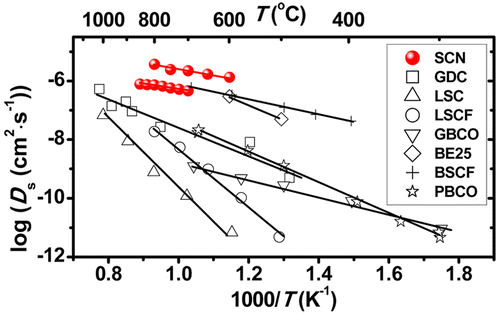当前位置:
X-MOL 学术
›
J. Phys. Chem. C
›
论文详情
Our official English website, www.x-mol.net, welcomes your feedback! (Note: you will need to create a separate account there.)
Unraveling Crystal Structure and Transport Properties of Fast Ion Conducting SrCo0.9Nb0.1O3−δ
The Journal of Physical Chemistry C ( IF 3.7 ) Pub Date : 2016-09-21 00:00:00 , DOI: 10.1021/acs.jpcc.6b07615 Chung-Yul Yoo 1 , Jong Hyun Park 1 , Dae Sik Yun 1 , Young A Lee 1 , Kyong Sik Yun 1 , June Hyuk Lee 2 , Hana Yoon 1 , Jong Hoon Joo 3 , Ji Haeng Yu 1
The Journal of Physical Chemistry C ( IF 3.7 ) Pub Date : 2016-09-21 00:00:00 , DOI: 10.1021/acs.jpcc.6b07615 Chung-Yul Yoo 1 , Jong Hyun Park 1 , Dae Sik Yun 1 , Young A Lee 1 , Kyong Sik Yun 1 , June Hyuk Lee 2 , Hana Yoon 1 , Jong Hoon Joo 3 , Ji Haeng Yu 1
Affiliation

|
SrCo0.9Nb0.1O3−δ (SCN) has been investigated for oxygen transport membrane and solid oxide fuel cell applications as it is more stable than the state-of-the-art Ba0.5Sr0.5Co0.8Fe0.2O3−δ (BSCF) material. Here, the crystal structure and transport properties of SCN were systematically investigated. Combined neutron and high-temperature X-ray powder diffraction analyses over the temperature range of 25–800 °C showed that the crystal structure of SCN belongs to the tetragonal space group P4/mmm with the unit cell ac × ac × 2ac, where ac is the lattice parameter of the cubic perovskite at temperatures <160 °C. The tetragonal (P4/mmm) to cubic (Pm3̅m) phase transition occurred in SCN with increasing temperature. This phase transition affected the electrical conductivity, whereas the impact on the magnetic susceptibility was not significant. The surface exchange and diffusion coefficients of SCN in the temperature range of 600–850 °C were characterized by electrical conductivity relaxation and oxygen permeation measurements. The self-diffusion and surface exchange coefficient of SCN are comparable with those of BSCF. Hence, SCN shows promise as a next-generation mixed ionic–electronic conducting ceramic.
中文翻译:

快速离子传导SrCo 0.9 Nb 0.1 O3 -δ的晶体结构和输运性质
的SrCO 0.9的Nb 0.1 ø 3-δ(SCN)已被研究用于氧气传送膜和固体氧化物燃料电池中,因为它是比国家的最先进的巴更稳定的0.5锶0.5钴0.8的Fe 0.2 ø 3-δ(BSCF)材料。在这里,系统地研究了SCN的晶体结构和传输性能。在25–800°C的温度范围内进行中子和高温X射线粉末衍射相结合的分析表明,SCN的晶体结构属于四边形空间群P 4 / mmm,晶胞为a c × a c×2一ç,其中一个Ç是立方钙钛矿在温度<160℃的晶格参数。正方晶(P 4 / MMM),以立方(PM 3米随温度升高,SCN中发生相变。该相变影响电导率,而对磁化率的影响并不显着。SCN在600–850°C的温度范围内的表面交换和扩散系数通过电导率松弛和氧渗透测量来表征。SCN的自扩散和表面交换系数与BSCF相当。因此,SCN有望成为下一代混合离子电子导电陶瓷。
更新日期:2016-09-21
中文翻译:

快速离子传导SrCo 0.9 Nb 0.1 O3 -δ的晶体结构和输运性质
的SrCO 0.9的Nb 0.1 ø 3-δ(SCN)已被研究用于氧气传送膜和固体氧化物燃料电池中,因为它是比国家的最先进的巴更稳定的0.5锶0.5钴0.8的Fe 0.2 ø 3-δ(BSCF)材料。在这里,系统地研究了SCN的晶体结构和传输性能。在25–800°C的温度范围内进行中子和高温X射线粉末衍射相结合的分析表明,SCN的晶体结构属于四边形空间群P 4 / mmm,晶胞为a c × a c×2一ç,其中一个Ç是立方钙钛矿在温度<160℃的晶格参数。正方晶(P 4 / MMM),以立方(PM 3米随温度升高,SCN中发生相变。该相变影响电导率,而对磁化率的影响并不显着。SCN在600–850°C的温度范围内的表面交换和扩散系数通过电导率松弛和氧渗透测量来表征。SCN的自扩散和表面交换系数与BSCF相当。因此,SCN有望成为下一代混合离子电子导电陶瓷。


























 京公网安备 11010802027423号
京公网安备 11010802027423号